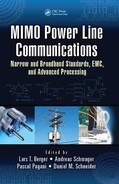Multiple-input multiple-output (MIMO) systems have been heavily investigated since the mid 1990s, targeting wireless communications. Nowadays, different MIMO processing options, with the aim of increasing data rates and communication reliability, are in operation in major wireless cellular systems such as WCDMA, LTE and WiMAX, as well as wireless local area networks (WLANs) based on IEEE 802.11n. Also, in the wireline world, digital subscriber line (DSL) systems have to deal with near-end and far-end crosstalk between individual modems. Recent developments treat DSL cable binders as MIMO communication channels, with the aim of applying multi-user coordination and interference mitigation techniques.
For a long time, the power line channel has been regarded as a single-input single-output (SISO) channel based on two conductors. In reality, many in-home installations make use of three wires, and medium- and high-voltage installations often have four or more conductors. Although the theoretical foundation of multi-conductor transmission line theory was extensively laid out in the last century, large-scale measurement results on MIMO power line channel and noise characteristics became available only in recent years, and only in 2011 did the International Telecommunications Union (ITU) publish a MIMO transceiver extension (G.9963) to their G.hn standard family. Simultaneously, the industry alliance, HomePlug, introduced MIMO signal processing within the HomePlug AV2 specification.
Demand for higher data rates and multi-user support is driven by increasing home entertainment and communication needs. For example, one can imagine a household whose inhabitants consume several high-definition television streams, while simultaneously browsing the Internet and making voice over IP (VoIP) calls. In this scenario, the focus is on high data rate applications with advanced quality of service differentiation. On the other hand, demand is also driven by the increasing number of intelligent devices that form part of the emerging Smart Grid. In such cases, coverage, reliability, and scalability are important attributes. Last but not least, the ever growing Internet of things (IoT) requires a huge amount of low data rate devices to communicate simultaneously, with stringent demands on power consumption and re-configurability.
All these aspects are reflected in this book, which gives a profound introduction to present day power line communications (PLC), as follows:
Part I: Power Line Channel and Noise: Characteristics and Modelling
Part II: Regulations, Electromagnetic Compatibility and MIMO Capacity
Part III: Current PLC Systems and Their Evolution
Part IV: Advanced PHY and MAC Layer Processing
Part V: Implementations, Case Studies and Field Trials
The individual chapters of Part I focus on narrow- and broadband channel characterisation, presenting measurement and modelling results from the United States, Europe and China. Building on this foundation, and taking into account current regulations and aspects of electromagnetic compatibility (EMC), Part II describes MIMO signal processing strategies and related MIMO capacity and throughput estimates. Current narrow- and broadband PLC standards and specifications are described in detail in the various chapters of Part III. Especially, the narrowband power line standards ITU-T G.9902, G.9903, G.9904 and IEEE 1901.2 are discussed, followed by individual broadband PLC chapters on ITU G.hn, IEEE 1901 and HomePlug AV2. Part III is rounded off by an introduction to hybrid systems based on IEEE 1905.1, combining PLC with other wireless and wireline technologies. Advanced PLC processing options are treated in Part IV, drawing from a wide variety of research areas such as beamforming/precoding, time reversal, multi-user processing and relaying. The book is concluded by Part V, which contains case studies and field trials where advanced technologies are explained with practical examples. Topics are as diverse as channel and noise emulation, cognitive notching, interference mitigation and MIMO PLC hardware feasibility.
All chapters are written as much as possible in a self-contained manner. Additionally, the chapters have been extensively cross-referenced, allowing each reader to pursue a personal reading path. We hope you enjoy the diverse contents contributed by experts from industry and academia, making this book one of the first of its kind in the exciting world of MIMO PLC.
Lars T. Berger
Andreas Schwager
Pascal Pagani
Daniel M. Schneider
Significant portions of this book, particularly Chapters 13 and 15, were excerpted from IEEE 1901-2010, IEEE Standard for Broadband over Power Line Networks: Medium Access Control and Physical Layer Specifications, and from IEEE 1905.1-2013, IEEE Standard for a Convergent Digital Home Network for Heterogeneous Technologies, copyright IEEE, and reproduced with permission by limited license from IEEE. Permission for further use of this material must be obtained from IEEE. Requests may be sent to [email protected]/sg. For a full copy of the standards, please visit IEEE’s online store at http://standards.ieee.org/store.
MATLAB® is a registered trademark of The MathWorks, Inc. For product information, please contact:
The MathWorks, Inc.
3 Apple Hill Drive
Natick, MA 01760-2098 USA
Tel:.508-647-7000
Fax: 508-647-7001
E-mail: [email protected]
Web: www.mathworks.com
